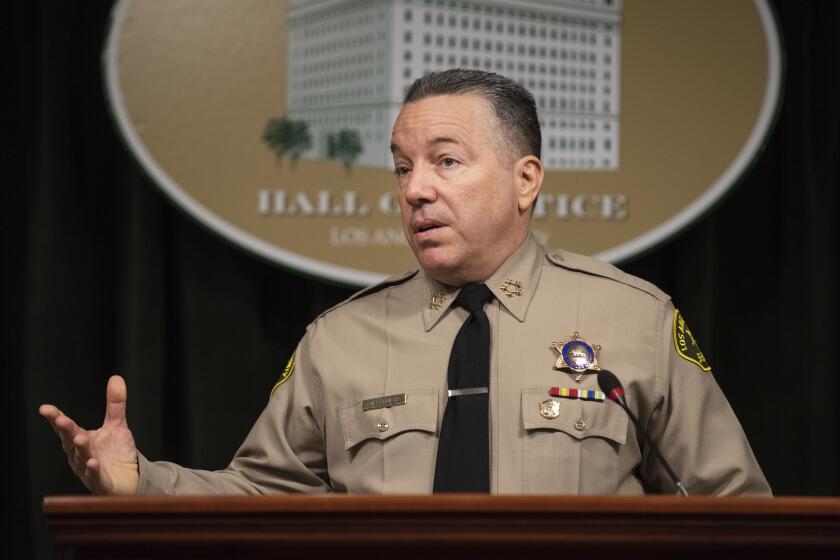‘Get up’ or ‘Don’t get up’? Video key to trial
A bystander’s dark, jittery video will allow a San Bernardino County jury to witness a sheriff’s deputy opening fire on an unarmed off-duty airman, and to stop, pause and rewind the frenzy that ended with three muzzle flashes and the deputy on trial this week for attempted voluntary manslaughter.
The district attorney thought the digital video recording, shot after a high-speed chase through Montclair and Chino in January 2006, was such damning evidence that Deputy Ivory John Webb Jr. became the first law enforcement officer ever charged in an on-duty shooting in the county.
But jurors may not be as convinced. With television and the Internet awash in raw, amateur video, from Osama bin Laden’s terrorist rants broadcast on Al Jazeera to the fictional lonelygirl15 videos on YouTube, audiences have become more skeptical and sophisticated about the images they see, and more open to alternative interpretations, legal and film experts say.
“We know historically that documentary film is dominated by the voice -- that we’re very prone to follow what it is that we are being told about what we are seeing,” said Michael Renov, a documentary scholar at the University of Southern California’s School of Cinematic Arts.
This especially could be true about the video recording in Webb’s trial, and the battle between the prosecution and defense: “The lawyer gets to provide the voice-over,” he said.
After watching the video of the Chino shooting, Renov drew a parallel to Akira Kurosawa’s 1950 film “Rashomon.” In that famous Japanese film, an event was shown from different perspectives and narrated by different characters, who each gave plausible explanations of what had transpired.
The low lighting, scant detail and shaky camera in the Chino shooting footage, Renov said, could play into the personal fears of members of the jury as they try to put themselves in Webb’s shoes to determine whether he committed a crime.
“It’s all dark, it’s murky, it’s hard to know what’s going on,” Renov said. “The less clear-cut the image ... the more possibilities there are for creating a compelling narrative that can help make the case you want it to make.”
Webb, who left the San Bernardino County Sheriff’s Department last year, is set to go on trial Monday for attempted voluntary manslaughter and assault with a firearm for shooting Elio Carrion, an Air Force police officer who was home on leave after duty in Iraq.
On the night of Jan. 29, an intoxicated Carrion was a passenger in a Corvette that led Webb on a high-speed chase that reached 120 mph through residential neighborhoods, ending when the Corvette crashed into a fence and Carrion jumped out of the car and onto the ground.
Both the prosecutor and defense counsel declined to discuss how they would lay out their cases over the next month. But in the preliminary hearing, they framed their questions about the video on the differing perspectives of the deputy, Carrion and Jose Luis Valdes, who shot the footage from his garden.
Valdes ran outside with his Sony camera after hearing the Corvette slam into a wall across from his house.
In the critical minute and 15 seconds on Valdes’ recording, Carrion is seen lying on the ground but with his upper body raised and twisted toward Webb and his face illuminated by the flashlight.
The driver of the Corvette, Luis Escobedo, is still in the car and not visible, but he can be heard shouting at Webb. Webb stands over Carrion with his gun drawn, repeatedly shouting expletive-laced commands to Carrion and Escobedo to “Shut up!”
One of the pivotal arguments in the trial will be over the movement of Carrion’s hands in those tense seconds.
In the video, Carrion is seen raising his left hand toward Webb at least twice; in a preliminary hearing Carrion said he was trying to shield his face from Webb’s flashlight. Then Carrion appears to use his right hand to gesture as he tells Webb several times, “We’re here on your side” and “We mean you no harm.”
In the final seconds before the shooting, Carrion tells Webb he is in the military.
“I served more time than you ... you have to believe me, all right?” Carrion says.
Webb tells Carrion to keep his hands on the ground. Then, according to the district attorney, Webb tells Carrion to “get up.” When Carrion says, “OK, I’m getting up,” Webb shoots him three times.
Laurie Levenson, a professor at Loyola Law School, said that after watching the video nearly 30 times she was still noticing movements by Carrion for the first time.
“What I see are still a lot of open questions,” she said. “The jurors are really being asked to put themselves in the officer’s shoes.
“He is dealing with someone from the military,” Levenson said. “They’re not cooperating.... [Webb is] outgunned and outnumbered.... Much of this just cuts both ways.”
Another critical task for the jury will be to determine exactly what Webb’s orders were in those final seconds.
In an initial interview with a sheriff’s sergeant at the scene, Webb said he repeatedly told Carrion to stay on the ground and fired his weapon because Carrion lunged at him.
Four days later, after the video was aired on TV news programs nationwide, Webb told detectives he fired because Carrion reached inside his jacket -- Webb thought for a weapon -- as he was disobeying orders by getting up.
Julius Wachtel, who teaches criminal justice at Cal State Fullerton and spent more than 20 years with the Bureau of Alcohol, Tobacco and Firearms, said he has analyzed the audio of the encounter a great many times -- and is certain Webb told Carrion, “Don’t get up.”
“There’s no question in my mind there’s a “Don’t” before “get up,” Wachtel said.
But Wachtel said Webb made a critical error by using a compound command instead of a simpler order like “stay down.”
“Everyone is operating in a very high state of anxiety. Both are thinking they are being clear, but they are talking over each other,” Wachtel said. “I’m not saying that shooting the man was justified, but let’s look at this in a more rational way.”
All of those questions will be addressed when the jury begins viewing enhanced versions of Valdes’ footage on a 52-inch high-definition flat screen television equipped with high-quality, free-standing speakers to help jurors hear the audio.
At least four versions of the tape may be shown during trial: the original without enhancements, a version enhanced by the FBI, a version enhanced by the Sheriff’s Department, and a digitized recording of the way the video looked to Valdes when he played it back on his camcorder, because he said that was the clearest version he had seen.
Neither the FBI nor the Sheriff’s Department would comment on how they enhanced the footage.
But Sgt. Mike Belicki, who spent nearly a decade in the Sheriff’s Department’s high-tech unit, said typical enhancements involve adjusting brightness and contrast, slowing the video frame by frame and using special tools to highlight certain areas, such as a suspect’s movements.
To clean up the audio, he said, the department often used filters to remove background noise or wind and to adjust pitch, and would sometimes send out the recording to specialists if detectives wanted to isolate and clarify individual voices -- likely to be the case with this tape.
The enhancements in the video and audio may provide yet more layers of complication for jurors to sort through, however.
One of Webb’s attorneys, Michael D. Schwartz, said he was still not sure how many versions of the tape and audio would be played during trial and what the extent of the enhancements might be.
“There’s no real guidelines, as long as you are documenting what you do,” Schwartz said. “We are making the assumption people are doing it with the best of intentions.”
*
More to Read
Sign up for Essential California
The most important California stories and recommendations in your inbox every morning.
You may occasionally receive promotional content from the Los Angeles Times.











